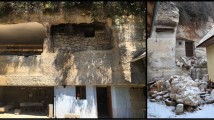Abstract
Samples were taken from the Carboniferous Limestone, the Magnesian Limestone, the Inferior Oolitic Limestone and the Great Oolitic Limestone. Their specific gravities, dry and saturated densities were determined, as were their absolute and effective porosities. The densities decreased and porosities increased with decreasing age of the limestone concerned. The permeability of these samples increased as the porosity increased. Furthermore the strength decreased with increasing porosity, that is, the Carboniferous Limestone was very strong whereas the Great Oolitic Limestone was moderately weak. When saturated the strongest limestone showed the least percentage reduction in strength. The strongest limestone also possessed the highest values of hardness, the weakest having the lowest values. As far as Young's modulus was concerned it tended to increase as density, strength and hardness increased. The Carboniferous Limestone recorded the highest values of Young's modulus, the Great Oolitic Limestone the lowest. Poisson's ratio and related elastic properties were also determined.
Résumé
On a prélevé des échantillons de calcaire carbonifère, de calcaire magnesien, du calcaire oolithique inférieur et du grand calcaire oolithique. On a determiné leurs poids spécifiques, leurs densités sèches et saturées et leurs porosités absolues et effectives. Les densités décroissent et les porosités augmentent selon le sens décroissant de l'âge du calcaire concerné. La perméabilité de ces échantillons était la plus grande quand la porosité augmentait. La résistance diminuait le plus quand la porosité était la plus grande. Cela veut dire que le calcaire carbonifére etait très résistant alors que le grand calcaire oolithique était relativement faible. Étant saturé, le calcaire le plus résistant montrait la plus petite réduction de résistance en pourcentage.
Le calcaire plus résistant possèdait une dureté la plus grande; le calcaire le moins résistant montrait la dureté la moins grande. Le module de Young tendait à s'accroître avec la densité, avec la résistance et avec la dureté croissantes. Le calcaire carbonifère avait le module de Young le plus grand, pendant que celui du grand calcaire oolithique était le plus petit.
On a aussi déterminé l'indice de Poisson et les propriétés élastiques qui y sont reliées.
Similar content being viewed by others
References
BELL, F. G., (1977): A note on the physical properties of the Chalk. Engng. Geol., 11, pp. 217–225.
BROCH, E. and FRANKLIN, J. A. (1972): The point load test. Int. Jour. Rock Mech. Min. Sci., 9, pp. 669–697.
DEERE, D. U. and MILLER, R. P., (1966): Engineering classification and index properties for intact rock. Tech. Rept. No. AFWL-TR-65-115, Air Force Weapons Lab., Kirtland Air Baise, New Mexico.
ENGINEERING GROUP, GEOLOGICAL SOCIETY, (1970): Working Party report on the logging of cores for engineering purposes. Quart. Jour. Engng. Geol., 3, pp. 1–24.
FARMER, I. W., (1968): Engineering properties of rocks. Spon, London.
Author information
Authors and Affiliations
Rights and permissions
About this article
Cite this article
Bell, F.G. A survey of the physical properties of some carbonate rocks. Bulletin of the International Association of Engineering Geology 24, 105–110 (1981). https://doi.org/10.1007/BF02595261
Published:
Issue Date:
DOI: https://doi.org/10.1007/BF02595261




